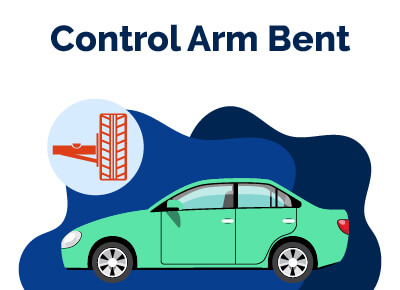Control Arm Bent (Causes, Symptoms, and Fixes)
July 23, 2023


Chris is Head of Content for FindTheBestCarPrice and is based out of Philadelphia, PA. As a seasoned automotive industry analyst and car enthusiast, he ensures the highest level of quality across all our content and curates our picks for the best deals each month.
Chris studied information systems and marketing at Drexel University and writes about a wide range of topics ranging from car buying tips to troubleshooting common mechanical issues.
When he’s not thinking about cars, he likes to stay in with his dog and make an “attempt” to finish a crossword puzzle (he’s not quite at the Saturday/Sunday level…yet). As a former cheesemonger, Chris still has a “sharp” passion for all things cheese, and his fridge is always loaded with it!
Chris also has a passion for things that go fast, and drones are no exception. He spends some of his time writing for Dronesourced.
In the realm of automotive suspension, a control arm, often referred to as an A-arm, functions as a pivotal suspension link between the chassis and the suspension upright or hub that supports the wheel.
Its primary purpose is to regulate a wheel's vertical movement, allowing it to react to road irregularities such as bumps or potholes. Control arms constitute the lower suspension link, playing an indispensable role in the vehicle's suspension system.
They help maintain proper tire contact with the road and align the wheels, thereby ensuring safety and stability. At the inboard end of the control arm, a single pivot, usually a rubber bushing, serves as the attachment point.
This allows the control arm to restrict the outboard end's position in only one degree of freedom, thereby maintaining a fixed radial distance from the inboard mount.
Let’s discuss a bent control arm, including its causes, symptoms, and fixes.
Let’s get started!
Table of Contents
- Control Arm Bent Symptoms
- Causes of Bent Control Arm
- Is It Advisable To Drive With a Bent Control Arm?
- How Much Does a Control Arm Replacement Cost?
- How To Inspect a Control Arm
- Is It Advisable To Replace Control Arm in Pairs?
- After Replacing a Bent Control Arm, Is an Alignment Necessary?
- Best Car Deals by Category
- Frequently Asked Questions
Control Arm Bent Symptoms
The following are symptoms of a control arm bent:
1. Unstable Steering
A further indication of issues with control arms is unstable steering, often resulting from deteriorating bushings.
When these fail, the steering alignment may become erratic, causing the car to swerve left or right when traversing bumps on the road.
This problem is particularly noticeable when driving on uneven or unstable terrain. However, this symptom may also signal problems with other steering components, such as the idler arm or steering tie rods.
Thus, sifting through all steering components is essential when conducting an inspection.
In addition, consistent vibrations felt throughout the vehicle can also suggest the beginning of control arm failure, though this is not the only possible cause.
Since the control arm acts as a vital link between the suspension and the frame and absorbs considerable energy, other issues, such as unbalanced tires or failing steering components, can exacerbate the situation if the control arms have weak components.
2. Uneven Tire Wear
An uneven tire wear pattern is yet another potential indication of a control arm bent, as it often points to alignment problems.
As the control arm bushings deteriorate, they can force the vehicle out of alignment, leading to wear on either the outer or inner edges of the tire.
While this may sometimes signal a simple need for proper alignment, worn bushings can also be the underlying cause.
In such cases, a reputable alignment shop can provide a precise diagnosis. You can find a list of Preferred Repair Shops in your vicinity that specialize in suspension diagnosis and alignment, including issues with control arms.
3. Loud Popping Noises
One of the initial indications of control arm failure is detecting a popping noise when driving over road irregularities.
Moreover, you may hear such a sound when accelerating or decelerating, mainly while traversing bumps at lower speeds, such as speed bumps. Typically, such occurrences point to a popping ball joint or possibly worn bushings.
4. Excessive Vibration
Another symptom of a defective control arm is excessive vibration, which is perceptible to the vehicle's occupants.
This vibration is often characterized as a persistent tremble or shimmy that typically fluctuates in intensity with speed changes.
As wear on the control arm increases, this vibration becomes more pronounced. Excessive shaking or vibration may also point to other problems, such as malfunctioning motor mounts.
Causes of Bent Control Arm
Control arms are susceptible to failure due to a variety of reasons, including natural wear and tear, as well as structural damage.
Despite being subjected to constant movement over a vehicle's lifetime, control arms are often weakened or destroyed by abusive driving.
Whether it be from colliding with a curb or forcefully striking a troublesome pothole, there are a plethora of road hazards capable of damaging even the most robust control arms.
If a control arm has already endured a significant number of miles, such an impact can exacerbate the damage and prove to be the last straw.
Is It Advisable To Drive With a Bent Control Arm?
It is imperative to understand that operating a vehicle with a defective control arm is discouraged and inherently dangerous and should never be attempted under any circumstances.
This is primarily due to the fundamental design of the control arm, which functions as a direct connection between a vehicle's wheel end and frame. Any disruption to this crucial link while in motion can have catastrophic consequences.
If a control arm were to fail while in use, steering would become unpredictable, and an accident could occur at any speed.
Moreover, the possibility of consequential damage to the vehicle resulting from such a failure is exceedingly high.
How Much Does a Control Arm Replacement Cost?
The cost of replacing a control arm is contingent on numerous factors, including disparities in the number of labor hours necessary for replacement and the unit price of the control arm.
Fluctuations in the prevailing labor rate among repair shops also tend to be significant.
The replacement cost will generally be higher at a car dealership service center than at an independent mechanic.
Given all these considerations, one can anticipate a cost range of $150-$400 to replace an individual control arm, although the figure can be substantially greater under certain circumstances.
Based on these figures, one would likely spend an average of $300-$800 to have the control arms of their vehicle replaced as a pair.
How To Inspect a Control Arm
Like several other suspension parts, control arms cannot be adequately scrutinized at a drive-through fast-lube establishment.
To examine control arms, the vehicle must be hoisted on a lift. This was the case with the vehicle proprietor featured in the photo, who had exclusively frequented a fast-lube shop for the past year, but the shop failed to detect a defective ball joint promptly.
Is It Advisable To Replace Control Arm in Pairs?
Replacing control arms in pairs is a commonly accepted practice due to various factors.
One of the most significant reasons for this is the tendency of all control arms in a given vehicle to display nearly identical wear patterns.
Thus, if one arm has become worn and requires replacement, the other will probably follow suit.
Furthermore, replacing control arms in pairs helps minimize free-play differences between a vehicle's opposing control arms. This ensures that neither front wheel end has a greater degree of free-play than the other.
After Replacing a Bent Control Arm, Is an Alignment Necessary?
Replacing one or more control arms on a vehicle does not necessarily warrant the expense of an alignment.
This is because control arms are solid-state components that lack the need for individual adjustments to the caster, camber, or toe.
On the contrary, if the need to replace the control arm arises from any impact, an alignment becomes a prudent investment.
This is because the same impact that damaged the control arm can also harm several other critical front-end components vital to a vehicle's steering geometry.
Best Car Deals by Category
Frequently Asked Questions
How can I tell if my control arms are bad?
Excessive vibrations, steering instability, uneven tire wear, and a clunking or knocking noise when driving over bumps are all signs of a bad control arm. However, the only way to confirm if your control arms are faulty is to inspect them by a trained mechanic.
Can I drive with bad control arms?
Driving with bad control arms is not advised, as it can cause various safety issues, such as erratic steering and potential wrecks. If you suspect your control arms are bad, having them inspected and replaced immediately is recommended.
How long do control arms last?
The lifespan of control arms can vary depending on driving conditions, road hazards, and the quality of the components. However, on average, control arms can last anywhere from 90,000 to 150,000 miles before needing replacement.
Can I replace the control arms myself?
Replacing control arms can be complicated and time-consuming, requiring specialized tools and knowledge. While experienced DIYers can replace control arms themselves, having a trained mechanic perform the replacement is generally recommended to ensure the job is done correctly.
Can I replace just one control arm?
While replacing just one control arm is possible, replacing both control arms simultaneously is generally recommended. This is because control arms tend to wear at similar rates, and replacing both control arms can help ensure even wear and consistent handling. Additionally, replacing both control arms at once can save time and labor costs in the long run.
Posted in Car Buying Tips, Car Troubleshooting |




